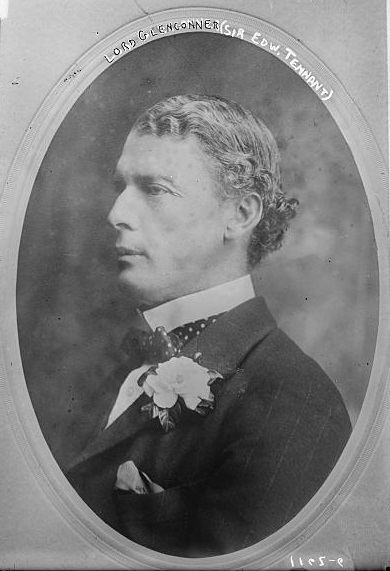Name Edward 1st | ||
 | ||
Edward Priaulx Tennant, 1st Baron Glenconner (31 May 1859 – 21 November 1920), known as Sir Edward Tennant, 2nd Baronet, from 1906 to 1911, was a Scottish Liberal politician.
Contents
The eldest surviving son of Sir Charles Tennant, 1st Baronet, he was educated at Eton College and at Trinity College, Cambridge. He married Pamela Wyndham, a writer, and had several children.
Tennant travelled extensively in Africa, India, and America, and was Assistant Private Secretary to Sir George Otto Trevelyan, Secretary for Scotland, from 1892-1895. He was unsuccessful parliamentary candidate for Partick in 1892 and for Peebles and Selkirk in 1900. He was elected as Liberal Member of Parliament for Salisbury at the 1906 general election, holding the seat until the 1910 general election.
He succeeded his father to the baronetcy in 1906, and in 1911 he was raised to the peerage as Baron Glenconner, of The Glen in the County of Peebles. Lord Glenconner was also Lord High Commissioner to the General Assembly of the Church of Scotland in 1911, 1912, 1913 and 1914, and served as Lord Lieutenant of Peeblesshire from 1908 to 1920.
Timeline
1859 - Birth on 31 May.
(1880s) - Educated Eton and Trinity college, Cambridge.
1883,4,6 - Travelled in South Africa and on the American continent, later visiting India and the Far East.
1885 - Graduated Master of Arts. (1886 in ).
1892 - Contested Partick Division of Lanarkshire as Liberal (unsuccessfully).
1892-1895 - Appointed Private Secretary at the Scottish Office to Sir George Trevelyan who was then Secretary for Scotland.
1895 - Married Miss Pamela Wyndham, sister of late George Wyndham.
1900 - Contested Peebles and Selkirk (unsuccessfully), being defeated by sitting member Sir Walter Thorburn.
1900 - Purchased Estate of Wilsford near Salisburgh, where he built a stately mansion in the Tudor style.
1902 - Toured Far East with Lady Tennant; present at the Delhi Durbar that year.
1906 - Second Baronet of the Glen, Peeblesshire, succeeding his father.
1906-1910 - MP for Salisbury, defeated 1910.
1910 apx - On redoing his house at 34 Queen Anne's Gate, to the galleries of art he had inherited he made a separate entrance for the public on certain days of the week, which was widely appreciated and used.
1911 - Peerage, taking the name "Lord Glenconner".
1911-1914 - Then appointed Lord High Commissioner to the General Assembly of the Church of Scotland, carried out with dignity, tact and courtesy, making him notable among the line of holders.
1914 - Presented to the Corporation of Glasgow 13 acres of land in the St Rollox district as a suitable recreation ground for that part of the city
1918 - Presented Dryburgh Abbey to the nation to save it from private ruin, which he had bought for it is said £35,000. This act was imitated by others, resulting in Scotland within two years possessing several ancient monuments in this way.
1920 - Death on 21 Nov at 21:15 from heart failure 10 days after an operation from which he seemed to have rallied. He was cremated at Golder's Green and his ashes buried at Traquair, Peeblesshire.
1920 - He was succeeded in peerage by his second son, the Hon. Christopher Tennant.
